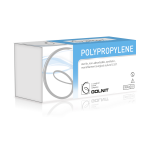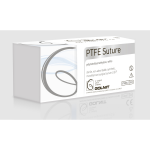PVDF sutures
Golnit PVDF Suture is a non-absorbable, monofilament sterile surgical suture composed of polyvinylidene fluoride. The suture is pigmented blue to enhance visibility.
- PVDF suture is a non-absorbable, monofilament sterile surgical suture
- PVDF suture is available from USP size 10-0 to 2
- PVDF is hydrophobic, inert and non-thrombogenic
- Suitable for use in combination with permanent implants
DESCRIPTION
PVDF suture is a nonabsorbable, monofilament sterile surgical suture composed of polyvinylidene fluoride. The suture is pigmented blue to enhance visibility.
INDICATIONS
PVDF suture is indicated for use in general soft tissue approximation and/or ligation, including use in cardiovascular, ophthalmic and neurological procedures.
ACTIONS
PVDF suture elicits a minimal acute inflammatory reaction in tissue, which is followed by gradual encapsulation of the suture by fibrous connective tissue. PVDF suture is not absorbed, nor is it subject to degradation or weakening by the action of tissue enzymes.
CONTRAINDICATIONS
None known.
WARNINGS
Users should be familiar with surgical procedures and techniques involving nonabsorbable sutures before employing PVDF suture for wound closure, as risk of wound dehiscence may vary with the site of application and the suture material used.
Do not resterilize. Discard opened packages and unused sutures.
As with any foreign body, prolonged contact of any suture with salt solutions, such as those found in the urinary or biliary tracts, may result in calculus formation. Acceptable surgical practice must be followed for the management of infected or contaminated wounds.
PRECAUTIONS
In handling this suture material, care should be taken to avoid damage from handling. Avoid crushing or crimping damage due to application of surgical instruments such as forceps or needle holders.
Adequate knot security requires the accepted surgical technique of flat, square ties of single suture strands. The use of additional throws is particularly appropriate when knotting PVDF sutures.
To avoid damaging needle points and swage areas, grasp the needle in an area one-third (1/3) to one-half (1/2) of the distance from the swaged end to the point. Reshaping needles may cause them to lose strength and be less resistant to bending and breaking. Users should exercise caution when handling surgical needles to avoid inadvertent needle sticks. Discard used needles in “sharps” containers.
ADVERSE REACTIONS
Adverse effects associated with the use of this device include wound dehiscence, calculi formation in urinary and biliary tracts when prolonged contact with salt solutions such as urine and bile occurs, infection, minimal acute inflammatory tissue reaction, and transitory local irritation at the wound site. Broken needles may result in extended or additional surgeries or residual foreign bodies. Inadvertent needle sticks with contaminated surgical needles may result in the transmission of bloodborne pathogens.
STORAGE
We recommend that the suture shall be stored under at a temperature of between 5 °C and 40 °C and relative humidity not exceeding 80%; the air shall not contain any aggressive admixtures.
PRODUCT PACKAGING
Golnit nonabsorbable sutures are packaged in two-pouch system of inner pouch and outer pouch. Golnit uses medical grade heat-sealable pouches that are for single use only and conform to the international product standards and norms: ISO 11607-1:2006, ISO 11607-2:2006, EN 868-5:2009.
METHODS OF STERILIZATION
Golnit nonabsorbable sutures are sterilized by validated ethylene oxide (EtO) sterilization system.




